The Spring 2012 Anime Preview Guide
Rebecca Silverman

Shining Hearts ~ Shiawase no Pan ~
Rating: 1 (out of 5)
Review:
Rick lives on a boat. He bakes bread. Airy, Neris, and Amil live in a bakery. They help Rick. People in town like bread. Elves in the forest like bread. Bread makes people happy. Everyone is happy, even though a big storm is coming. Oh, but the narrator isn't happy. She is depressed. We don't know who she is. We don't know why she is sad. Maybe Rick should give her bread! Bread makes people happy.
Apart from the cruelty of watching this during Passover, because this show is just filled with bread that I can't eat, Shining Hearts really is lacking in important things like plot and interest. The story takes place on a beautiful, pastoral island called Windaria. Rick, for reasons that are not explained in this episode, works at Le Coeur Bakery making bread. He lives on a ship that has somehow been beached perfectly upright and apparently something bad happened to him in the past that involved a storm at sea and the sound of swords. But who cares about that? Not the characters of this show, apparently. Rick spends his days with Airy (blue), Neris (red/pink), and Amil (green), three apparent sisters who lead color-coded lives at the bakery. Each has her own fetishy mode of dress (Nun! Apron! Falling out of her dress!) and specific bust size and they do cute things like save sylphs in the woods and pose for still shots of them eating bread. Have I mentioned how many times the camera lingers over loaves and rolls in these twenty-four minutes? It makes one wonder if the original game's creators had a bread fetish.
In any event, by the end of the episode, our four protagonists have made bread, sold bread, eaten bread, fed bread to woodland creatures, had their bread rejected by a haughty blond elf named, of all things, Alvin, and gone home. Rick has a two-second flashback to his past and Alvin and his sister Lana make ominous noises about a storm while the episode is opened and closed by the musing of what sounds like the world's most depressed anime girl, who, unless she is the bread, appears nowhere in this show.
So long story short – if you have played the game, you may enjoy this. If you just enjoy looking at pastoral fantasy settings, you might like this. If you have a huge attraction to or fondness for bread, this may work for you. But if none of those things intrigue you, Shining Hearts ~ Shiawase no Pan ~ (and yes, I am aware that “bread” is right there in the title) is best left on the shelf.

Arashi no Yoru Ni
Rating: 3 (out of 5)
Review:
An unusual 3D offering, Arashi no Yoru Ni is part allegory, part life lesson and all sweet. One stormy night, young goat named Mei stumbles into a run down shed to shelter from the storm. Moments later she is joined by Gabu, a wolf, who is also seeking shelter. The two begin to talk and, despite the fact that they cannot see each other, are struck by how similar they seem to be. They quickly become friends and plan to meet the next day for lunch. Imagine their surprise when Mei turns out to be Gabu's usual meal. But they decide to go through with their picnic anyway, and though Gabu has some moments where Mei looks more like lunch than his lunch buddy, things go well and the two plan to meet again.
Based on first a series of picture books and then on an animated film, subtlety is not this show's credo. It is a story for children with the very obvious goal of teaching them that just because someone says that you shouldn't get along with someone else, that doesn't mean that you ought to listen. Gabu's voice indicates that he's older than Mei, which could be why he has more difficulty with their initial relationship. Mei, meanwhile, takes everything that Gabu tells her at face value and trusts him implicitly. It is this that really wins Gabu over in the end – how could he betray the trust that she has so touchingly given him? It is easy to take the story out of the context of animals and transfer it to the schoolyard and I daresay that an English version of this would be fairly popular with parents. While the CG isn't perfect (particularly in terms of textures), it does give the show a very marketable air both in terms of appeal and toys. Adults may not enjoy Arashi no Yoru Ni as much as their younger counterparts, but it is still easy to be charmed by it and to hope that Mei's sweet optimism continues to pay off.
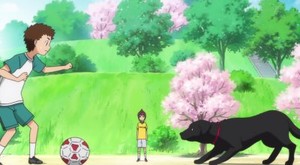
Ginga e Kickoff
Rating: 2.5 (out of 5)
Review:
Don't compare this to Knight in the Area. It'll be tempting – after all, both shows are about boys who want to play soccer – but where last season's soccer show took itself very seriously, Ginga e Kickoff is a lighthearted soccer-themed romp about Shou, the boy who isn't a very good player and speaks in exclamation points. Our story begins with Shou's sixth grade team, the Predators, being disbanded. Shou begs to at least be put on the fifth grade team, but the manager informs him that there's no hope for a benchwarmer. Shou throws himself at the manager in supplication but only succeeds in pulling off the man's pants and underwear. Undeterred by this unfortunate event, Shou rides off on his bike, determined to rebuild his beloved team.
This is where the series starts to get a little silly. Shou immediately meets Erika, a recent transfer student with amazing soccer skills and a soccer playing black lab named Zach. Wait, what? Okay, well, fine. Erika taught her dog to play soccer. Shou asks her to join his team, which he conveniently doesn't mention is no longer in existence, and she tells him that she'll join if he can beat her dog. At soccer. But this is a kids' show, so perhaps we can overlook this. The next day Erika and Shou go to talk to the manager about practice, at which point the man tells Shou that he doesn't have a team and that Erika is a girl and so in no way could be any good at a sport. This understandably infuriates Erika, and the two ride off only to find a World Cup soccer player for the Japanese women's team practicing in their spot. Somehow this coincidence, when paired with Shou just happening to meet Erika who just happens to have been on a famous team back home, is a bit much to take. Of course Shou convinces the professional soccer player to play with them and makes a bet that she must do something for them if they beat her...and it doesn't take much imagination to see where that goes.
Luckily Ginga e Kickoff seems to know that it's a little ridiculous. Characters mention all the coincidences and Shou acknowledges that he always talks! Like! This! Even the opening scene where Shou is daydreaming about his team playing on the world stage has some wink-and-nudge humor with the professional team all drawn relatively realistically before the camera moves to our big-eyed brightly colored youngsters. These moments save the show from being a farce that takes itself as something else, and if you go into this expecting goofiness founded on cosmic coincidences, it's kind of fun. But if you're looking for a serious sports show, it doesn't look like you'll find it here.
 Eureka Seven Ao
Eureka Seven Ao
Rating: 3.5 (out of 5)
Review:
Ao is a foreigner living in Okinawa, something neither he nor the audience is ever allowed to forget. One night while out combing the beach he encounters Gazelle and his group of potentially less than legal transporters delivering sensitive cargo to the Japanese military. There is a “scub burst,” an explosion of energy and scub coral that summons up a monster, and Ao runs off with a bracelet that was supposed to be part of Gazelle's cargo. Before much can come of this, another massive scub burst begins, destroying the island and forcing Ao to realize that the bracelet he now holds may have the key to his past.
This is just the main surface of the show, of course. Ao also has a friend named Naru who suffers from what appears to be asthma. Naru has a cute little sister and a pet sloth, both of whom will probably figure into the show more, at least if the original series is to be any sort of guideline. Will Gazelle fill the role of Holland from the first Eureka Seven? It is hard not to watch this and make those comparisons simply because so much of this world is vaguely familiar to us, right down to the fact that it's no holds barred when it comes to killing innocent bystanders. That said, right now it looks like familiarity with the original show will not be necessary to enjoy this one, although it will provide tantalizing hints of Ao's past.
As far as first episodes go, Eureka Seven AO has one of the more action-packed debuts of the season, throwing you into a world at the moment of its destruction. They do take the time to establish that this is a highly xenophobic future with casual prejudices thrown around while also showing the transition from our technology to a more advanced one – ships and cars such as exist in our world coexist with Ao's flying vehicle, which looks like a truncated VW bus. Make no mistake, this has potential as an exciting futuristic tale of death-soaked derring-do. It needs a couple of episodes to really get off the ground, though, and to see if it can give us something different than its parent series did.

Tsuritama
Rating: 4 (out of 5)
Review:
Yuki is our second protagonist in a row to have spent his school life transferring around, only in his case it's for his grandmother Keito's work. When our story begins, Yuki is finishing out his last day at school and worrying about his exit speech. You see, Yuki panics when stared at or put on the spot, feeling as if the ocean is rising up to engulf him, which causes him to make an oni face. Needless to say, this freaks people out. But he's basically okay with things, and when he and his grandmother arrive at their new home in Enoshima, he's thrilled to see that they're so close to the ocean. Mind you, this will have unexpected consequences...
Our second main character appears to be Haru. We first meet him wandering around Enoshima with what looks like a fighter fish in a bowl on his head. The fish talks to him, and they appear to be looking for something. On their search they stop at the Enoshima Aquarium, which some viewers may recognize from Princess Jellyfish. There Haru demonstrates an amazing ability to control the fish, and a triangular halo appears over his head. When he leaves the building, he sees Yuki drive by, which leads him to seek the other boy's house out and announce to Yuki's highly stylish grandmother that he will be moving in. Oh, and that he's an alien.
“Quirky” would be a good word to apply to Tsuritama. Haru is irrepressible, much to Yuki's dismay, and soon has Yuki and local fishing champ Natsuki out on the pier with rods and lures. The show's artwork has an underwater quality to it, with light reflections shaped as if they were on or under the water. The opening folktale about a dragon who terrorized Enoshima in the past and the ending animation are done to resemble papercraft, helping with the overall folksy feel to the show's setting. There's something odd about the whole thing, but it's a good strange, the kind that makes you wonder where the show is going and what will happen next. Is Haru really an alien? Why does he want Yuki to help him save the world? Who is that talking fish? At this point, it's worth following this to find out.
Tsuritama is available streaming on Crunchyroll.
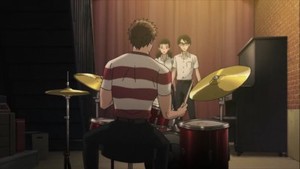
Kids on the Slope
Rating: 5 (out of 5)
Review:
“It don't mean a thing if it ain't got that swing,” Ivy Anderson once sang to the accompaniment of Duke Ellington. Kids on the Slope, Noitamina's latest offering, takes that lesson to heart. Sometime in the 1960s, Kaoru is the new kid at school...again. The Japanese equivalent of an army brat, Kaoru has been following his single father around since elementary school and now events have landed him in Kyushu with his aunt, uncle, and cousin Mariko. From the brief scene we see of this new home life, it's clear that he's a male Cinderella. Add to that the fact that so many school changes have left him prone to panic attacks, Kaoru is not a happy camper. The one exception is when he is playing the piano.
Enter Sentaro, the apparent school delinquent. Kaoru meets him when he's trying to reach the roof to stave off his panic induced nausea and the two share an oddly homoerotic moment. Sentaro, whose hands we saw drumming incessantly earlier in the episode, towers over other students and looks like the local badass – Kaoru was even warned away from him previously. But Sentaro is really just an overgrown little boy with energy and sense of fun that makes him an immediately likeable character. He latches onto Kaoru despite the new boy's trepidation, and with Ritsuko, Sentaro's childhood friend, the three form an uneasy trio. It is Ritsuko who lets Kaoru in on Sentaro's secret – he plays jazz drums. The episode ends with Kaoru beginning to think about jazz piano instead of classical, and the show is set to go from there.
The fact that I love jazz aside, this show has great promise. The small details of the 1960s – one of the records in the shop run by Ritsuko's family is “Surfin' USA” - and the little character gestures that make them more human (witness Kaoru's casual removal of his glasses around Ritsuko), Kids on the Slope looks set to cope with the small moments as well as the large. The jazz backgrounds add atmosphere and anime fans should enjoy seeing a story played out in a building that we normally see as “the old haunted schoolhouse” in shows with contemporary settings – it gives a feeling of nostalgia even though it is in a culture not our own. The shading is a little odd, as is some of the walking in the opening scenes, but overall this looks good. Crunchyroll's subtitles were a little off as of my viewing, but hopefully that will iron itself out before too long.
Later in the song I mentioned, Ivy sings, “It makes no difference if it's sweet or hot. Just take that rhythm, give it everything you got.” That seems to be Kids on the Slope's credo at this point – despite that fact that not much has happened, there's a lot going on internally. If this show keeps giving its all, it should be a winner.
Kids on the Slope is available streaming on Crunchyroll.
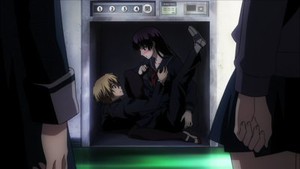
Dusk Maiden of Amnesia
Rating: 3 (out of 5)
Review:
Yuuko is the president of the Paranormal Investigation Club, but some of the members have never seen her. There's a good reason for that - she's a ghost. Possessing club member Teiichi Niiya, Yuuko seems to be responsible for most of the paranormal activity that the club investigates, all the while making Niiya seem like he has some sort of sixth sense to doting club member Momoe. Kirie, the fourth member, may or may not be able to see and hear Yuuko; at this point it's a bit unclear. Regardless, Yuuko is a well-known school spirit, and the end of the episode has the club visiting a grave on a hill behind the school that may be hers.
If Dusk Maiden of Amnesia can decide whether it wants to be funny, scary, or haremy, it might turn out to be quite an interesting series. At this point it feels like a rehash of Ghost Hunt with a focus on the funny and doesn't quite work as well as it could. There are some very nice artistic touches with still sepia shots and one scene in a dumbwaiter taking place in a series of stills with continuous vocals, and the way the first eight minutes are shown twice, first sans Yuuko and later with her, is a neat idea and encourages the viewer to pay attention to the details. However Momoe's shrillness and the clear set up of she and Yuuko as rivals for Niiya's affections brings the episode down, as do attempts at comedy, once again mostly attributable to Momoe's inability to see Yuuko. The ghost herself provides enough intrigue to make this worth another couple of episodes before deciding whether this is worth watching or not – why can't she remember her past? What is the bell all about? How did she die in the first place, and when? - but if these questions are either answered too quickly or unsatisfactorily, the show's goofier aspects could overwhelm them. So make up your mind, Dusk Maiden. Do you want to be a serious ghost story or a supernatural spoof? Once that's settled, this attractively animated show can find its audience.
Dusk Maiden of Amnesia is available streaming on Crunchyroll.
 Mysterious Girlfriend X
Mysterious Girlfriend X
Rating: 3 (out of 5)
Review:
Let's just get this out there – drool/spit/saliva is right up there with egg whites and maggots on my personal top ten list of Stuff That Grosses Me Out. So I was all prepared to hate this show and write it off as the latest in a line of weird fetish anime that clearly was not meant for my personal consumption. As it turns out, if I averted my eyes during key moments, Mysterious Girlfriend X was a surprisingly decent show. In part this is due to the interesting use of background music – mostly carnivalesque pseudo-horror instrumentals – but a lot of credit must also go to Ayako Yoshitani, the voice of heroine Mikoto Urabe. She takes what might have been a moe-style “weird girl” and gives her charm and depth, particularly when she speaks after laughing – her voice takes on a warm quality that makes Urabe more human.
Since I'm late to this party, I will assume readers of this guide are familiar with the story's premise and focus on my impressions. The details of this show are particularly good. Urabe has a UFO charm on her schoolbag and uses a pen with the same motif. Series protagonist Akira has a clear but unspoken fascination with old-school science fiction and his room is filled with posters for recognizable sci fi films despite copyright protecting title changes (“Star Mars” and “The Day the Mars Stood Still” are both clearly shown.) This, along with Urabe's UFOs and the strange attraction he has for her saliva, hint at something beyond what we're given and make us question Urabe's denials of being supernatural, which is either a great red herring or some nice foreshadowing. Interestingly enough, background details are more contemporary than the characters themselves, with the designs having a distinct 80s feel, slightly reminiscent of Rumiko Takahashi's designs. This makes some of the sexual innuendo seem odd, and make no mistake, while this is more subtle than Upotte, that's not necessarily saying much. There is a definite undertone of sexuality and the use of spilling and pooling liquids makes that abundantly clear, just in case the opening montage of butterflies pollinating flowers didn't get the message across.
While Mysterious Girlfriend X is not my kind of show, it is still one that looks good, has a unique, if squicky, premise, and seems to show some good production values. If you can get past all of the drool, it is worth checking out.
Mysterious Girlfriend X is available streaming on Crunchyroll.

Nyarko-san: Another Crawling Chaos
Rating: 3.5 (out of 5)
Review:
Mahiro seems to be having some bad luck – a Lovecraftian monster is pursuing him through town, apparently bent on his destruction. He calls desperately for help...and a cheery voice calls out, “Hai!” as a female hand slices through the monster, splattering Mahiro with blood. The voice belongs to a teenage girl with long silver hair and an outfit that could belong to Monster High's Frankie Stein in goth loli mode. Her name is Nyarlahotep, and she's the chaos that crawls up to you with a smile! Nyarko, as she tells kids at school to call her, has come to protect Mahiro against the beasts that would, for unspecified reasons, like to kill him. This of course necessitates that she move in with him, so as to be with him from “good morning to goodnight.” Mahiro isn't sure that this is the best situation to be in, especially after Nyarko declares her love for him as an addendum to how she of all the gods of the Cthulu Mythos got this job. This is a formula that we've seen before and non-harem fans might be shuddering, but something about Nyarko-san: Another Crawling Chaos is delightful, keeping it above other similar titles. This episode enjoys small meta moments, with Nyarko's backstory fast-forwarded (complete with squeaky VHS sounds), comments about how the show will get taken off the air if the characters aren't careful, and a slew of images in a store that have a very familiar look to them. Add to that some sentai jokes and a Pokemon reference and you've got a parody element that helps to make this more palatable than it might appear at first glance.
Another draw is Nyarko herself. While Mahiro at this point falls comfortably into the “blank slate male lead” mold, Nyarko is way too perky for a creature of a well-known horror mythology and generally a lot of fun to watch. She's always moving and switches conversational modes at the drop of a hat, ensuring that viewers will always be rewarded for keeping an eye on her. It helps that she looks nice as well – rosy without the scraped look that so many anime characters get when animators try to give them rosy limbs or cheeks, and her pinafore and dress combination looks cute without being too fetishy. She also has a proportionate body without either inflate-a-boobs or a little girl figure. The animation isn't perfect, but there's enough flow that it's easy to watch and the music has a definite sense that it could grow on you.
H.P. Lovecraft may well be spinning in his grave, but this is still a fun show. It looks like more members of the Cthulu Mythos will be coming in in future episodes (one of whom is severely underclothed, but she has fire hair ties, which sort of makes up for it in my book), and hopefully the show will be able to maintain its fast and fun pace without devolving into more typical supernatural harem fare. Lovecraft purists may be disappointed, but those looking for amusement shouldn't be.
Nyarko-san:Another Crawling Chaos is available streaming on Crunchyroll.

Hiiro no Kakera episode 2
Rating: 2.5 (out of 5)
Review:
This second episode increases the otome game feel of Hiiro no Kakera, unsurprising given its origins. Whereas last time the show was more concerned with introductions, now we move into Tamaki learning what being a Tamayori princess is all about...but kind of get lost along the way. Takami announces her determination to learn her family's past and gets as far as opening the locked shed wherein that information resides, but then immediately has some sort of magic seizure and gives up. “That voice is the same as the one in my dream,” she thinks...and doesn't pursue the matter any further. Given that she was so eager to learn before, and that the episode opens with her having her second weird dream since her arrival at Granny's, it doesn't quite fly that she'd be deterred so easily. As for her brave men, they don't show evidence of much more personality than in the previous episode, although Mashiro does have some knowledge that surprises the others and may prove to make him a more rounded character than he seems right now. As a bonus, Yuichi doesn't fall asleep at all this time, once again suggesting a bit more to him than “narcoleptic quiet guy.”
This episode also goes a bit further in terms of showing us the bad guys, one of whom looks like she walked over after finishing up Brave 10. If you've been feeling the lack of Goth loli, butler types, or a dude with an eye-patch, rest assured – the villains have you covered. Grandma also shows a bit of what might be called her “true” personality, as well as what the relationship between she and Mitsuru might be, thus still giving a reason to come back next week and see what's going on. But this remains pretty strictly for reverse harem fans, from the typed guys to the vaguely unsettling moments after the credits where one of the male leads looks at the camera and tells you he had fun and will be waiting for you next week. Better than Brave 10 but not as much campy fun as Uta no Prince-sama, this remains both fun and forgettable.
Hiiro no Kakera is available streaming on Crunchyroll.

Saki: Episode of Side-A
Rating: 2 (out of 5)
Review:
Shizuno is passionate about a game that isn't hugely popular with the under 80 set in the U.S. (to my knowledge). She became even more fond of the game playing it with friends when she was in the sixth grade. One friend moved away and another went to a different middle school. Shizuno wants to compete in her game, but her projected high school doesn't have a club, so she must gather five members. Does this sound familiar? Probably because the last time we saw this show it was called Chihayafuru and was about karuta. This is Saki: Episode of Side-A and is about mahjong, and believe me, it doesn't hold up well to the comparison.
For a first episode, this spin-off of the Saki series has a lot of information. We go through three years in Shizuno's life, starting when she's in the sixth grade and ending up with her in the ninth. She and buddy Ako have been playing mahjong at a local girls' school when they meet “frilly” transfer student Nodoka, who also loves the game. This is great until their teacher is scouted by a professional mahjong league and the class is shut down. Ako goes to a different school so she can play competitively, Nodoka transfers because of her mother's work, and Shizuno continues to run around without pants when she's not in her uniform. (Seriously, the girl just wears a jacket no matter what grade she's in.) Then suddenly Nodoka's on TV winning a middle school mahjong tournament and suddenly Shizuno and Ako, along with class sempai Kuro, remember how much they loved playing mahjong together and decide to start up a club. It's hard to care, really, when all of this is thrown at you in a bare twenty-four minutes. We don't care that Ako and Shizuno are being separated by their school choices because we simply don't know them well enough to. Likewise Nodoka's entrance and exit are so brief that, along with an out of place fanservice shot at the end, we just get the impression that she's the boobs of the operation. If this episode had taken its time, and if Shizuno felt more like an original character rather than a less charming Kyoko from Yuruyuri, this might have been enjoyable – after all, Chihayafuru amply proved that it isn't so much the topic as how its down that makes a series good. As of right now, though, this show is exactly as much fun as a show about a table top game sounds – not very.
Saki: Episode of Side-A is available streaming on Crunchyroll.

Upotte!!
Rating: 0 (out of 5)
Review:
Rarely have I felt so creepy when watching something, anime or not. Upotte!! is the special sort of terrible that is, quite simply, terrible with no clear redeeming values, at least not for someone who neither enjoys assault weapons nor finds middle school girls sexy. The story centers on a special school for girls who are, in fact, guns. I'm not sure how this works, to be honest, since when FNC (Funco to her friends) shoots her teacher, she pulls out an actual FNC rather than using her...her...actually, given that we clearly have some sort of female body = gun parts metaphor going on here, I'm not sure where the bullets would come out of. Clearly the gun's butt is the girl's butt (although how “skeleton” equates to “thong” I am not sure) and I'm fairly certain that the trigger and the clitoris are one and the same, but beyond that things get a little fuzzy. I'm going to say that's a good thing.
Upotte!! disturbs on several levels. One is the fact that it is glamorizing assault rifles, although that may be a more personal issue depending on your political views. The other is the blatant sexualization of middle school girls. There's nothing wrong with the fact that that's the age when many begin to recognize their own sexuality, but the blatant way that Funco is shown fondling herself and fighting back arousal/orgasm for the viewer's delectation when she thinks about her new teacher's big hands on her is frankly creepy. Add to that the fact that the teacher's face is in shadow most of the time, implying that he is a stand-in for the viewer, and you've got some seriously prurient material for a non-hentai show. If this is where the anime industry is headed, I weep for us all.
Upotte is available streaming on Crunchyroll.

Kuroko's Basketball
Rating: 3.5 (out of 5)
Review:
Recent urban legend speaks of a school with a “Miracle Generation” of basketball players – five guys who were astoundingly good at the game...and maybe there was a phantom sixth? Flash forward to Seishin High School, a two-year-old academy with, unsurprisingly, a basketball club. Riko Aida is the surprising coach – a second year student with an uncanny talent for sizing up someone's stats simply by looking at him with his shirt off. She and other club members are scouting for new members and land two worthy of mention – Taiga, a burly arrival from the U.S., and Kuroko, a guy with next to no presence whatsoever. Kuroko hails from the same middle school as the Miracle Generation, and it doesn't take long to figure out which member he is.
Kuroko's Basketball (humorously phrased as “The Basketball Which Kuroko Plays” on the title card) isn't hugely surprising in terms of set up or plot. Taiga and Kuroko are immediately recognizable as the important characters by their unusual coloring and the basketball scenes use a lot of still shots rather than costly animation. We know we're going to be either cheering for an unlikely underdog team or watching the assembly of a new Miracle Generation; it just isn't clear which yet. But despite the stranger moments (Riko and her stats) and the semi-cliches, this is an enjoyable show. Speaking as someone who really doesn't care for sports, there was enough going on to keep me interested, and while shortcuts were most definitely taken on the animation front, the games are still dynamic and the characters move well. A decision to shade under the chin with lines rather than shadow makes everyone have a bearded quality (not good on Riko) and background players are decidedly generic, but for the most part this is an episode that holds your attention. Basketball fan or not, those looking for some shonen team building fun need look no further.
Kuroko's Basketball is available streaming on Crunchyroll.

Natsuiro Kiseki
Rating: 3 (out of 5)
Review:
Saki, Natsumi, Yuka, and Rin have apparently been friends forever. The girls are paired off into two groups – quiet Rin and exuberant Yuka and loyal Natsumi with serious Saki. Four years ago they heard about a magic wishing rock that would grant any wish four friends all wanted together while touching it. Now second year middle school students, Rin and Yuka are just as close and enthralled with the idea of a magic rock while Natsumi and Saki have grown apart. Saki seems to be going through some typical middle school angst and is having a hard time relating to her friends anymore. Natsumi, meanwhile, feels totally betrayed by Saki's change in attitude and the way she's bailed on their winning tennis partnership. Rin and Yuka set up a meeting at the rock to try and bring them back together with some surprising results.
Natsuiro Kiseki isn't quite the cute girls doing cute things show it appears at first glance. Saki's very real middle school attitude saves it from that, as does the fact that the group of four isn't totally inseparable. Natsumi and Saki are definitely the more interesting of the leads because of that – Rin and Yuka have more of a stock character vibe, particularly given their personalities. The show is not without tropes – of course one of the girls lives at a temple and two others are next door neighbors with windows that look in on each other – but its peaceful flow and unexpected hints of the supernatural make it a cut above other similar endeavors. Also interesting is the fact that no other classmates factor into the group dynamic – we see them, as we do Saki and Natsumi's mothers, but they are on the periphery of the action, giving this more of a closed feel. It works so far, though it could later make the view too narrow. Depending on how things go with Saki and Natsumi, this could continue to be a pleasant diversion with some depth or it could devolve into a cutefest. Right now, though, it's worth giving another episode.

Accel World
Rating: 4.5 (out of 5)
Review:
How much time do you spend online escaping your reality? For high school first year Haruyuki, he wishes it could be more. Unusually for an anime hero, Haru is short, fat, and unattractive. He's bullied by a gang of thugs and feels inferior in general, except when he escapes to what appears to be an MMORPG to play squash. That's the only place, he tells us, where he can feel worthy, and his high scores are out of this world. Then one day he arrives to find that someone has beaten him – the beautiful butterfly avatar wearing Kuroyukihime, vice president of the student body. Kuroyukihime, most likely a word play on that most innocent of all fairy tale princesses Snow White (Shiroyukihime), invites him to meet her at lunch, where she hooks him up with special software called “Brain Burst.” This allows him to live in an accelerated world, to step outside of reality and have time to consider his next move. But by the end of the episode it looks like this may have unintended consequences, as the moment he sets foot on school grounds he enters a mech-suited battle...
Accel World takes a premise that .hack//whatever has done to death and makes it interesting again. The idea of a virtual world where we can fully escape, not just sit and type and maybe hear other players, is as appealing as walking through a wardrobe or falling down a rabbit hole – all of us yearn for an escape sometimes, and this show makes it seem so easy. Of course this is due to the technology explained in the episode's opening moments – with the development of something called the “neurolinker,” people are now as connected as possible to the internet, to the point where there are always collapsed windows in their peripheral vision. The neurolinker itself seems to be a sort of torque or collar, and it isn't entirely clear whether or not people can take them off. This constant connectedness makes for some chilling imagery – people wave their hands, point their fingers, and make typing motions for reasons that we cannot see. My sister commented that with the invention of the bluetooth, it was impossible to tell the crazy people from those on cells anymore – this takes that observation and multiplies it.
It helps that this episode both looks and sounds good as well. The virtual worlds are each distinct and have imagery that ranges from fantasy gorgeous to gritty post apocalyptic and the avatars that people design for themselves also show a range from cute to clearly fetishized. The instrumentals in the background have a ballad-like feel and enhance without distracting from the action. The show does ask that we accept an awful lot right off the bat, and clearly there's going to be some childhood friend romantic conflict that could very easily drag the show down, but for a first episode, this is very promising.
Accel World is available streaming at VizAnime.

Sankarea
Rating: 3 (out of 5)
Review:
I must preface this review by saying that my family lost a cat yesterday and that may have colored my opinion of this show.
Furuya Chihiro is the son of a Buddhist temple. He lives with his father, grandfather, and younger sister Mero. His cat Babu was part of this equation until he was hit by a car about five minutes into the episode. The family buries him off of temple grounds and it is apparent that Chihiro is taking his pet's death pretty hard. That's when he recalls his opening monologue (not literally) – Chihiro is a zombie otaku. He just can't get enough of the undead, to the point where he dreams of one day meeting a “cute zombie girl.” Yes, for romance, which does make him a necrophiliac. In any event, Chihiro heads to his closet, where he has an old necromancer's notebook. Then he digs up Babu, puts him in a cooler, and proceeds to spend his nights in an old bowling alley trying to resurrect his kitten. While he's there he sees a beautiful girl, Sanka Rea, yelling down an old well. When she notices him, he invites her inside and shows her what he's doing. After some conversation, he says he'd date her if she were a zombie. Whether or not the following scene that closes out the show is real or his imagination remains to be seen.
Creepy themes aside, Sankarea is at least interesting in its concept and unafraid to show the gruesome side of it. Chihiro is off-putting in the degree to which he takes his zombie obsession, and his character design with his hair mimicking dog ears is strange, but Rea looks very attractive and the animation is smooth. Backgrounds can feel a bit stock, but overall this show looks quite nice. Sensitive viewers may not find this to their tastes, but this is one of the more interesting shows to come out this season and for that alone it deserves some praise.

Yurumates 3Dei
Rating: 3 (out of 5)
Review:
Yurume is an eighteen-year-old who has just moved to Tokyo to go to college. She's all excited to live in what she wrongly assumes is the high class Maison du Wish, which turns out to be more Maison Ikkoku, complete with wacky neighbors who use her room for at least one drinking party. What's more, the elderly landlady tells her that none of the boarders who are enrolled in cram school ever make it to college! Yurume is having some serious second thoughts about this whole Tokyo thing...
Yurumates 3Dei is wacky in a familiar way. Sure we all know this story and can guess where it's headed, but it looks like the show has the energy to carry it off. The art is a little reminiscent of Hyberbole and a Half's with its little hooked hands and facial expressions, and where this might be disconcerting in a longer episode, at three minutes it works just fine. This looks like one of those nice little brain break shows that you can just put on and zone out to for a few moments – fun, cute, and low on the brainpower required to watch.
Yurumates 3Dei is available streaming on Crunchyroll.

Gakkatsu
Rating: 2 (out of 5)
Review:
I think this show got lost on the way to Cartoon Network. That may not be entirely fair to say, but the visual style of Gakkatsu is chunky and square, not unlike some of the NickToons or CN shows. The characters do very little emoting beyond sweat drops and the dialogue is mostly shouted. The plot revolves around the homeroom period of a specific middle school class. The class president has decided that today they will discuss “the bumpy thing,” by which she means the bone that protrudes on the top of one's wrist. No one knows what it's called and they're all quite freaked out by it until the class medical nerd proclaims its proper terminology. Class president quickly denounces the name as unfitting and they rename the bone. And so pass five minutes. In all honesty Gakkatsu isn't so much bad as it is less than fully enjoyable. The art is unattractive and the characters mostly without appeal in terms of personality. If the homeroom discussions get more interesting, this could improve, but as of this episode, it fails to engage my interest.

Acchi Kochi
Rating: 1 (out of 5)
Review:
First steam the brisket for one hour at 350 and then slice against the – oh, sorry. This is supposed to be a review of Acchi Kochi's first thrilling episode. How could my mind have wandered so? The answer to that lies in the fact that Acchi Kochi is somewhat less thrilling than making brisket for 30. This first episode takes us through the day of five high school friends, tiny Tsumiki, bespectacled Io, cute Hime, brash Mayoi, and everyman Sakaki. Tsumiki has a mad crush on Io, who may or may not be aware of it, but she certainly can't bring herself to say anything. She's little and cute with a disproportionate amount of hair, and the show never lets you forget just how little and cute she is, most often by giving her purple cat ears to match her mostly purple hair. I say mostly because there are some light blue patches that are perhaps supposed to be highlights but instead look like the paint is wearing thin. Over the course of their day they go to school, have class, eat lunch, play games at an arcade, and use a photo booth. This is precisely as thrilling as it sounds.
Parts of Acchi Kochi really try to be interesting. Scene changes are announced with arrow bedecked title cards, probably in reference to the title, which could be translated as “here and there.” In the arcade Sakaki wants to play a game called “Fighting Idiot,” and Tsumiki's favorite character is some sort of maimed bunny doll. Mayoi has the unusual talent of fixing mechanical things, which almost makes up for her stock character personality. But the ol' slipping on a banana peel, vaguely incompetant spinster teacher, and “white undies, hur hur hur” all rear their ugly heads and don't do a fairly dull show any favors. If you like bright colors and teeny heroines, there may be something here for you. Otherwise this is about as much fun as living through an ordinary high school day yourself.
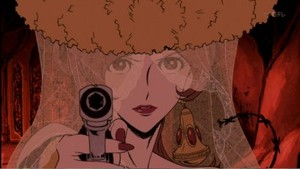
Lupin III: The Woman Called Fujiko Mine
Rating: 5 (out of 5)
Review:
This ain't Geneon's Lupin III. The newest incarnation of everyone's favorite thief is a grittier, more adult variation of the popular tale, taking the story back to the days before Lupin and Fujiko were a team. This episode introduces them – Lupin and Fujiko have both targeted the same ecstatic cult for its drug supply. Fujiko has taken the route of passing herself off as the aged cult leader's latest scantily clad bride, while Lupin is using his usual methods, right down to sending Inspector Zenigata a note informing him of his intentions. Fujiko and Lupin decide to compete to see who can get the goods first using their disparate skills and the episode goes from there.
Visually, this is a fascinating show. It retains the classic Lupin look, unusual in this day of round girls, and everything has a gritty filter over it, making lines thicker and the shadows grainier. A few “Ali Baba and the Forty Thieves” references spice things up, and Fujiko has a lush but relatively proportionate body. This episode gives you plenty of time to admire it, as Fujiko spends most of the episode in various states of breast-and-butt-exposing undress. There is also some implied sex and graphic French kissing, not to mention the overtly sexual nature of the black and white opening theme, so this is not a show to watch during lunch at work. But it does add to the adult appeal of the episode, making this a welcome change in a field increasingly crowded with less grown-up fare. From its visuals to its plot, not to mention its jazz soundtrack, this entry into the Lupin III franchise is a delight for both new and established fans alike.

Sengoku Collection
Rating: 2 (out of 5)
Review:
Ohta doesn't seem to have a whole lot going for him – single, part time job at a convenience store, and on his ride to work a busty pink-haired lady falls out of the sky and headbutts him. She claims to be Oda Nobunaga, and while Ohta isn't convinced, we as viewers have already watched her fall from a burning wooden structure (bridge? Porch?) and glide through time in order to be in contemporary Tokyo. Clearly either history left a whole lot of things out, or Nobunaga comes from a parallel world. Since this is the subtitle, there's not a whole lot of guesswork to be done. Most of the episode focuses on Nobunaga hanging out with Ohta and learning about things like hamburgers before stopping to pray at a small shrine. Later she receives a visit from the spirits who protect it, telling her that they will send her back to her world if she can assemble all of the “Secret Treasures” that great warriors carry within them. Luckily they also tell her that other great warriors from the alternate past are also kicking about modern day Japan, and thus the plot of the series is born.
This really is a mixed bag of a show. Nobunaga's personality seems to waffle between wide-eyed wonder and comments about burning castles down, making her seem less like the moe flavor of the month and more uninterestingly unhinged. Ohta is a total blank slate, serving only to ferry her around on his scooter and feed her convenience story bento boxes, or alternatively to get flustered by her obligatory stripping or pressing her barely-in-the-dress boobs against his back. The fact that she (and presumably he) will now be running all over trying to find these Secret Treasures feels like a combination of lame RPG quest and an excuse to reimagine famous warlords as underclothed girls. The plus here is that the girls look pretty nice, with some imaginative touches to their designs which, while incongruous like Nobunaga's Disney princess tiara, make the females in the show visually pleasing. Sengoku Collection may turn out to be better than this episode indicates, but at this point it has a fetch-and-carry feel to go with its two cardboard characters.
Sengoku Collection is available streaming on Crunchyroll.

Medaka Box
Rating: 3 (out of 5)
Review:
Kurokami Medaka is the newly elected student body president of ludicrously wealthy Hakoniwa Academy with a 98% victory despite the fact that she's a first year. Medaka has but one goal – to solve any and all student problems which are deposited in her request box. No mission is too high or low for the overachieving Medaka, a girl who, narrator and childhood friend Hitoyoshi Zenkichi tells us, has always seen herself as somehow superior to others. In this first episode, Medaka solves the dual issues of third year thugs who have taken over the kendo dojo and Hyuga, a bespectacled boy with a bad personality. Zenkichi,as he explains to Shiranui, our token loliesque character with blue hair that forms an apparently sentient question mark above her head, is not all that keen on helping Medaka, but he fears that he will be pulled in anyway, as he is a self-confessed tsundere for her.
Let's not fool ourselves here – two of the stars of this show are Medaka's breasts, with the camera going out of its way to show them jiggling gently as they bulge from her special uniform top or place them as the foreground to another character's speaking role. Luckily they, and the rest of the episode, look pretty good – one scene of a character slowly swinging a sword in a circle looks especially fluid and nice. Overall the animation is of a higher caliber than your average boob show, and Medaka herself, although a little annoying in terms of her obvious superiority complex, may shape up to be likeable. Voices and sounds compliment the characters and the action, and overall this is a very well put together episode. The plot isn't thin, though it does feel contrived, but really the biggest issue for this show will be whether or not Medaka, the girl who sees herself as some sort of guardian of the universe, will become someone we enjoy following or instead spiral down into the depths known as “really obnoxious.” It's a comfort to know that it should at least look good whichever way it goes.

Polar Bear Cafe
Rating: 2 (out of 5)
Review:
As far as unusual anime worlds go, Polar Bear Cafe has one of the odder ones. In this version of reality, animals and humans live together and no one seems to notice. This would be fine if there weren't also zoos that hire animals part time to act like, well, animals, implying that people are aware that there is something a bit off about the way a polar bear with a taste for bad puns runs a popular restaurant or that a panda mother threatens her son with the vacuum cleaner, thus confirming my dogs' fears. Presumably one is simply supposed to let these details float past on the show's relaxed atmosphere, and it almost works. In fact, if it weren't for the zoo, this would be a perfectly reasonable show about humans and animals coexisting in the modern world, anime-style.
That little issue aside, Polar Bear Cafe is slightly too long at twenty-four minutes. Panda, the protagonist of the tale, is a lazy son who just wants to loll around eating bamboo. His mother thinks that he should do something else with his life, so he sets out to find the least grueling part time job that he can. On his ambles he discovers the Polar Bear Cafe, run by, you guessed it, Mr. Polar Bear. Mr. Polar Bear is looking for a part timer, but none of the animals who apply work out for reasons peculiar to their species, and he ends up hiring one of the show's two named human characters, Sasako. (The other is Handa at the zoo.) Meanwhile Panda fils finds work elsewhere. Strictly speaking, this would have made for a very boring half-episode or two minute show, but it isn't that much more interesting as a full length one. The concept is cute, but the pace is lagging. Fans of slow-paced slice of life shows will probably enjoy this one and it does provide enough novelty to merit giving it a shot. You'll know soon enough if this will charm you or bore you.
Polar Bear Cafe is available streaming on Crunchyroll.
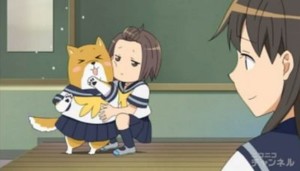
Shiba Inuko-san
Rating: 1 (out of 5)
Review:
Like 90% of anime heroines, Chako Ishibashi is an ordinary eighth grade girl. She puts on the same uniform everyday, she goes to school, she forgets her Japanese textbook. Luckily she can share with the girl who sits next to her, Shiba Inuko-san. She's...uh, well, she's a large shiba inu in a school uniform. No one else in the class seems to realize that Inuko is a dog, and even Chako “only suspects.” The big gag is that a classmate can't figure out where she'll find a dog, which her horoscope says is her lucky item for the day, while hugging Inuko and rubbing her belly. This is a pretty thin premise even for a two minute show. Last season's Poyopoyo at least had its charm for the cat lovers out there and both Morita-san wa Mukuchi and Recorder and Randsell both had their moments of humor. But this? As gags go, it's already all used up – what will Inuko do in future episodes? Eat from the garbage? Fetch sticks and go for walks? It's not that a funny show can't be made out of cute animal antics, but this one feels limited in its capacity for interest. Hopefully I'll be proven wrong, but at this point, consider me underwhelmed.

Kuromajo-san ga Touru!!
Rating: 3 (out of 5)
Review:
Chiyoko, AKA Choco, is an occult fiend. She loves summoning spirits, drawing magic circles, and all other related practices. One night while trying to summon “Cupid” with what looks like a kokkuri game, she accidentally summons “Gyubid,” a black witch. Even when she explains to him that she didn't mean to call him and it was all the fault of her stuffy nose, Gyubid insists that he is going to teach her how to be a black witch, which she must have subconsciously wanted. While what this is isn't precisely explained in the show's seven minutes, he does help her rid the school of an unwanted spirit presence and make her wear a red and black goth loli outfit, which she thinks is a bit silly.
For a short, this is a lot of fun. Kuramajo-san has a magical girl feel to it without actually being that kind of show and the magic system is reminiscent of Magic User's Club, so there's a bit of nostalgia for fans of that series. Also in the seven minutes the show manages to make a point about how some adults who work with kids try to ingratiate themselves and sometimes do more harm than good, although this is played for wry humor rather than pathos. Choco and her friends are simply drawn with very round eyes and bright colors, and the show is clearly geared towards middle grade girls. It is tempting to wish that this had longer episodes, but when all is said and done the half-episode length is probably for the best. Kuramajo-san gets to be cute and entertaining without overstaying its welcome, and there is definitely something to be said for that.
 Saint Seiya Omega
Saint Seiya Omega
Rating: 2 (out of 5)
Review:
Were you a fan of Saint Seiya before? If so, this show will be a real trip down memory lane and probably a whole lot of enjoyment that a passive viewer/reader of the franchise just didn't get. Saint Seiya Omega follows Kohga, a boy whom we first meet as a baby in the goddess Athena's care. When green-eyed Athena (someone didn't read his Homer) is attacked by Mars, the universe-bedecked, wasp-waisted villain, she and Kohga are saved by Saint Seiya himself in his gleaming golden armor. Flash forward somewhere between fourteen and sixteen years. Kohga is living by the sea with a woman calling herself “Saori” who is clearly Athena and being subjected to rigorous saint training by the torpedo-boobed Shaina. He's not thrilled with this and doesn't see why he has to become a saint, but suffice it to say that by the end of the episode he and his amazing “cosmo,” or “inner power,” have things figured out.
There is a real retro feel to this show from the character designs to the resurrection of the original opening song to the overwrought emotions. Kohga isn't as melodramatic about his situation as he could be, but that is amply made up for by the heavily lined artwork and dramatic animations, particularly in any battle scenes. There's a bit of a cheap feel to some scenes, with characters looking fairly off-model when seen from a distance and a lack of faces during those same distance shots. Perhaps this is in tribute to the original incarnation of the anime...but it just feels lacking today. All of that said, there is some potential for this show in a rough-and-tumble shonen sense, particularly if you like sentai shows or are simply a fan of masculine melodrama or men with lovely little waists. As for me, this episode has left me with one burning question – why is Mars, a Roman god, after Athena, a Greek goddess, and fighting with guignir, a Norse weapon?
Saint Seiya Omega is available streaming on Crunchyroll.
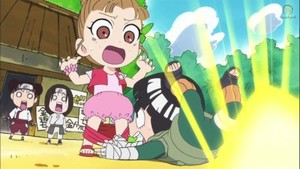
Rock Lee and His Ninja Pals
Rating: 3 (out of 5)
Review:
Well, color me pleasantly surprised. Rock Lee and His Ninja Pals, an SD spinoff of the infamous Naruto series, requires little to no familiarity with its parent series and also provides some basic laughs over the course of its twenty-four minutes. Focusing on the titular Rock Lee, an enthusiastic ninja wannabe who lacks any and all ninjutsu skill, the series is a gag-based journey through Lee's misadventures. In the first half he attempts to help a young girl beset by burly loan sharks by using his mysterious and totally not made up technique “depantsification.” While this is definitely fourth and fifth grade territory, as is the focus on gleaming golden piles of dog poo, Lee's utter ineptitude is entertaining and nicely balanced by straight man Ten Ten, who questions the existence of certain conveniences in the story's world and later tells an enthusiastically recapping story to please “keep it in-world.” In the second half of the episode, Lee, Neji, and Ten Ten are tasked with getting a baumkuchen for a client, only to find that Naruto is after the same goal. While a little Naruto knowledge will help here, this is still pretty funny for the uninitiated, and “harem jutsu” clearly needs to be a real thing. (On second thought...maybe not.)
Simply drawn and done in great good fun, Rock Lee is nothing strikingly different but certainly manages to enjoy itself, which there is something to be said for. Lee is a goof, but he's a determined one, and that makes him fun to follow, even when the story takes turns for the juvenile. Even the anti-Naruto faction may find something to like here, if only because Naruto himself comes off as less than perfect and an object of ridicule. To make a long story short, Rock Lee and his Ninja Pals looks bright and cheery, is fun and good-hearted, and is a great escape after a trying day, the kind of show I would have watched with a bowl of cereal on a Saturday morning, and sometimes, that's really all you need.
Rock Lee and His Ninja Pals is available streaming on Crunchyroll.

Zetman
Rating: 4 (out of 5)
Review:
At some point in an undisclosed but modern time, the rich and bored liked to gather to watch gladiatorial matches fought by semi-sentient beings known as “players.” Their bloodthirst seemed relatively harmless until one day the players gained full self-awareness and went on a rampage. Most spectators and monsters were killed, but a few escaped, including an old scientist with an infant in a capsule...ten years later, a little boy named Jin lives in a shantytown with his grandfather. Jin has something called an “angel's ring” on his hand – a strange raised circle that his grandfather keeps covered up. Jin and his friends Kouga and Konoha have some sort of juvenile crime fighting group, even though Jin clearly has mysterious special powers. When one of the escaped players goes on a rampage, and Kouga and Konoha's unpleasant father decrees that they must never see Jin again because he has committed the sin of being poor and homeless, Jin's powers come to the fore in a brief but exciting battle.
This episode is clearly meant to serve as background for the rest of the series, as the ending theme images show Jin and co. as presumable teenagers, which is a bit too bad, as little Jin is rather more visually pleasing. With his tragic past firmly in place and several key emotions learned, the story is all set to take off as a dark fighting epic. “Dark” is actually the perfect word to describe this show: not only is the plot pretty much devoid of lighter moments, it is also animated in a very grim palate, with even the blood taking on a gloomier hue than we typically see. There's a tiny bit of censorship – lots of steam covers naked breasts in a tub scene and a light bar obscures one moment of violence early on – but this is clearly a darker show and it isn't afraid to let you know that. Overall it is engrossing, pulling you in even as you recognize that it has its faults, something that has always been a strength of original author Masakazu Katsura. It remains to be seen how the gruffly charming characters make the jump to young adulthood, but so far, this show has potential and just enough of a Batman vibe to make it worth checking out.
Zetman is available streaming at VizAnime.
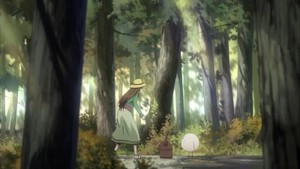
Hiiro no Kakera
Rating: 2.5 (out of 5)
Review:
Tamaki is an apparently ordinary high school girl whose parents have been sent to an unspecified African country for work. This means that she's going to stay with her grandma in the mountainous region of Japan known to anime fans as “the place with no cell reception.” When no one is at the bus to meet her, Tamaki decides to walk through the woods to Grandma's house. Naturally she is attacked by giant tarry eyeball monsters, and even more naturally she is saved by a gruff and mysterious attractive young man. He helps her (grumpily) to her destination, at which point Grandma tells her that she is a “Tamayori princess” and must use her powers to seal something called the “onikirimaru.” Over the remaining minutes of the episode, Tamaki meets her mascot character and three more potential romantic interests who will all serve as her protectors: small and angry Mashiro, tall and elegant Suguru, and narcoleptic Yuichi.
It isn't a good sign that I watched this when Crunchyroll offered it as a season preview and had to rewatch it in order to preview it for you. Obviously there isn't a whole lot here to separate it from the reverse harem herd, but what promotes it from a “2” to a “2.5” are some nice world-building touches and a heroine who is much less of a milquetoast than, say, Haruka from UtaPri. Tamaki isn't just a bland girl all set to unleash her magical powers on the world, nor is she devoid of all personality or overwhelmed by her situation. She's just a pretty average kid who thought she was coming to stay with her grandmother and is a little miffed by the whole Tamayori-hime thing. Meanwhile the supernatural world that Grandma describes is just interesting enough to merit our attention – ghosts, she explains, are just gods that people have stopped believing in, so those monsters from the beginning of the episode are “drowned gods” because they no longer have any worshipers. This is just unique enough to merit a higher rating and to give the show a chance to show off its magic system further. Other than that, however, this is strictly for the reverse harem fan, and even they will be able to tell at a glance who the real romantic lead is and who is going to betray everyone. But hey, at least getting there should be a little fun, even if the episode is already fading from my mind once more.
Hiiro no Kakera is available streaming on Crunchyroll.
 Space Brothers
Space Brothers
Rating: 4.5 (out of 5)
Review:
Mutta was born on the day of a great sports failure for Japan. Three years later, his brother Hibito was born on a day of great sports success. Although he never explicitly says it, Mutta seems to worry that this is an omen that will rule their lives and becomes convinced that as the older brother he must always be one step ahead of Hibito. So is it another omen when, as young boys, Hibito first spots the UFO that will change their lives? Both boys vow to become astronauts, but twenty years later, only Hibito is headed into space as part of a NASA mission. Mutta has become a successful engineer, but a rash act has him unemployed and grossly overqualified for any available jobs. Living with his parents again, he clearly feels like a loser, especially when he compares himself with Hibito. Hibito, on the other hand, only wants the best for his big brother, and by the end of the episode, things are definitely looking up for our beleaguered hero.
If you're looking for something with both a brain and a heart, Space Brothers is a good place to start. The relationship between the two brothers is both real and wonderful and if that isn't enough (and if you didn't just see “space” in the title and immediately know you had to watch it), it looks pretty nice too. Both Mutta and Hibito have slightly unusual designs that give them an edge over the usual pretty boys and the animation looks smooth even when it takes shortcuts. Even though it's set in the future of 2025, the whole show has an appealing retro quality, calling to mind the excitement of early space adventures both real and fictional. While I admit that as one of the kids who watched The Challenger blow up at school I have a leery feeling about the show, hopefully it is unfounded, because right now, this is looking like a winner.
Space Brothers is available streaming on Crunchyroll.

Folktales From Japan
Rating: 3 (out of 5)
It has been said that all great stories start with “once upon a time.” That may not strictly be true and certainly espouses a narrower view of literature than I like to take, but there is still something comforting about a folk or fairy tale, and Folktales From Japan has that “grandma's house” feel. Comprised of three short stories over the course of twenty-four minutes, this introductory episode gives us “The Old Man Who Made Flowers Bloom,” “The Man Who Bought Dreams,” and “The Rat Sutra.” All three are similarly, although not identically, animated on the cheap – pudgy, squidgy characters with potato-shaped heads waddle around in limited animation and much of the show is narrated. It isn't pretty, especially to a western audience used to similar tales illustrated by Arthur Rackham and Edmond DuLac, but as a children's show intended to introduce kids to Japanese folklore, it works, and the subtly different designs for each segment add some interest.
Although the tales may not be entirely familiar to a non-Japanese audience – no Momotaro here – viewers should still find a sense of sameness that in a folktext context is very soothing. The first story is one that is present in multiple cultures, the story of the kind who reap rewards and the greedy who are punished, known as “The Three Little Men in the Woods” in the Brothers Grimm collection, or more commonly as “that one where the toads fall out of the bad girl's mouth.” Likewise the middle tale gives us a similar story of virtue rewarded. As you might guess from the title, the third story is the most uniquely Japanese but still is very easily understood by a different cultural audience. The only note that may seem off is the fact that the greedy couple in the first segment has noticeably darker skin than the good couple.
As far as starts to the season go, this is interesting and ultimately harmless. And for you animal people out there, I can offer one further comment – one of my cats just loved watching the paper plane and cherry blossoms in the opening theme, making this a show that apparently aims to appeal to animals as well.
Folktales From Japan is available streaming on Crunchyroll.
discuss this in the forum (1032 posts) |
this article has been modified since it was originally posted; see change history
back to The Spring 2012 Anime Preview Guide
Season Preview Guide homepage / archives